Subscribe
Sign in
Leave it all to: Lattice!
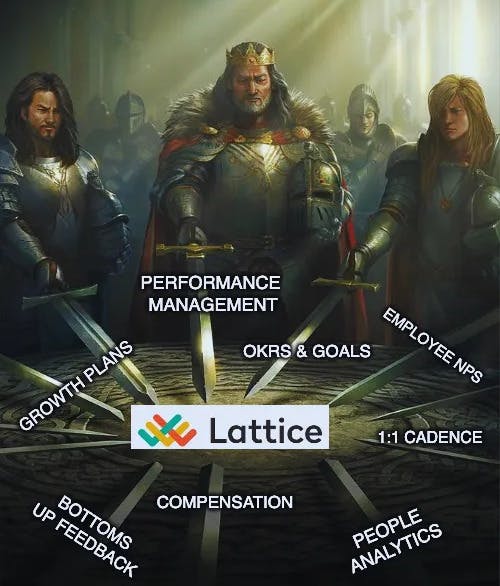
Share On
How a strong belief in valuing the people behind your business led to the birth of a unicorn worth $3 billion today.
Ruchin Kulkarni is a co-founder at Toplyne where he leads all things Growth. Previously an investor at Sequoia Capital, he writes about SaaS and product-led growth (PLG) at the Top of the Lyne newsletter. Find him on Twitter at @Ruchin_Kulkarni.
The ancient Romans weren’t very big on performance management.
A worker ‘worth their salt’ was just someone who did the job they were told to do and got paid in one of the most valuable commodities at the time - salt. Their working hours or efficiency didn’t really matter. It was quite literally a different time.

Payday: Ancient Rome.
By the time the industrial revolution rolled around, the system of work had become slightly more sophisticated. For one, the world had moved on from compensation in salt (heavy sighs of relief), and money had been injected into the workforce.
But it was still pretty easy for factory owners to spot a good worker. All you had to do was punch in on time, work the assembly line, and not take too many breaks. Workers who did a task well and on time were rewarded, and those who didn’t were penalized.
A simple system for simpler times.
The times we live in now, however, have computers. And many of us are no longer assembling parts in a factory.
So how do you measure good work in today’s knowledge economy? Is it the effort you put in? Or the results? Is it what your manager thinks of you? Or are you good at your job because you’re well-liked by clients and colleagues?
The answer isn’t an easy one, but mankind’s best attempt has a new name: Lattice.
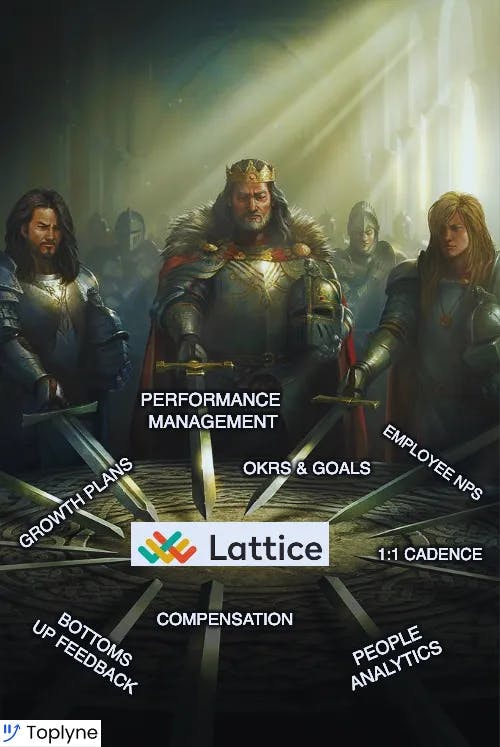
Many use-cases. One platform.
🚀 It all began... at another startup
Lattice founders, Jack Altman and Eric Koslow first met at Teespring (now Spring), a social commerce platform that allows people to create and sell custom products. Eric was one of their first engineering hires - and Altman - VP of Business Development.
They both witnessed Spring’s meteoric rise from 10 to 500 employees - in under two years.
That rocket ship gave Jack the itch to start his own venture. He approached Eric with the idea - and a founding team was born.
Jack and Eric’s first idea was a pharmacy benefit management platform - but they quickly realized their hearts weren’t in it and moved on from the idea after a few months.

Pharmacy benefit management platform?
What finally got their attention was something that had caused a ton of frustration at their previous job: the perils of fast growth ⚠️
“We wanted to help teams be more focused, aligned, and motivated because we’ve been part of growing teams and know how much of a difference it makes,” said Altman.
How do you keep employees productive and happy in a high-growth, high-stress startup environment?
Jack and Eric believed that motivated people are key to business growth. People aren't motivated by snack bars and ping pong tables. Beyond business results, what people really want are clear goals, an environment of growth, and highly motivated coworkers they can learn from.
“I really believe that the companies that invest in the core pillars of successful employee experience are going to be the companies that win.” - Jack Altman
Meet Lattice. 💁🏻♀️
Lattice was incubated in the Winter 2016 cohort of Y Combinator (where Jack’s elder brother, Sam Altman was also President at the time) and fashioned itself as modern performance management. The key insight upon which Lattice is founded is that the existing praxis of reviewing employees’ performance via feedback and reviews was getting redundant, and most importantly: employees hated them.

Employees at performance review processes: pre-Lattice (colorized)
Building on this and eating into an untapped market of companies with a headcount of 30 - 500 people, Lattice was able to position itself as the only-people-management software you need at a neat budget.
And voila! Jack and co. went from zero to over 225 companies that used it in less than a year. 🚀
Building on this momentum, the company raised a $6.4M Series A led by Thrive Capital, with participation from Khosla Ventures and SV Angel! 💸
Today, 6 years after their YC incubation, Lattice is valued at a whopping $3B valuation and loved by over 4,500 customers worldwide, including some really big “players” - the Los Angeles Dodgers for one, and other high-growth cos. like Slack, Asana, Clio, Slice, and Glossier, to name a few.
Today, Lattice's goal-setting product aligns goals across a company's team + individuals to make sure everyone’s rowing in the same direction.
If G2 reviews are an indicator (if you’re shopping, they often are), Lattice is hitting the ball out of the park to help people teams achieve increasing retention and motivation overall.
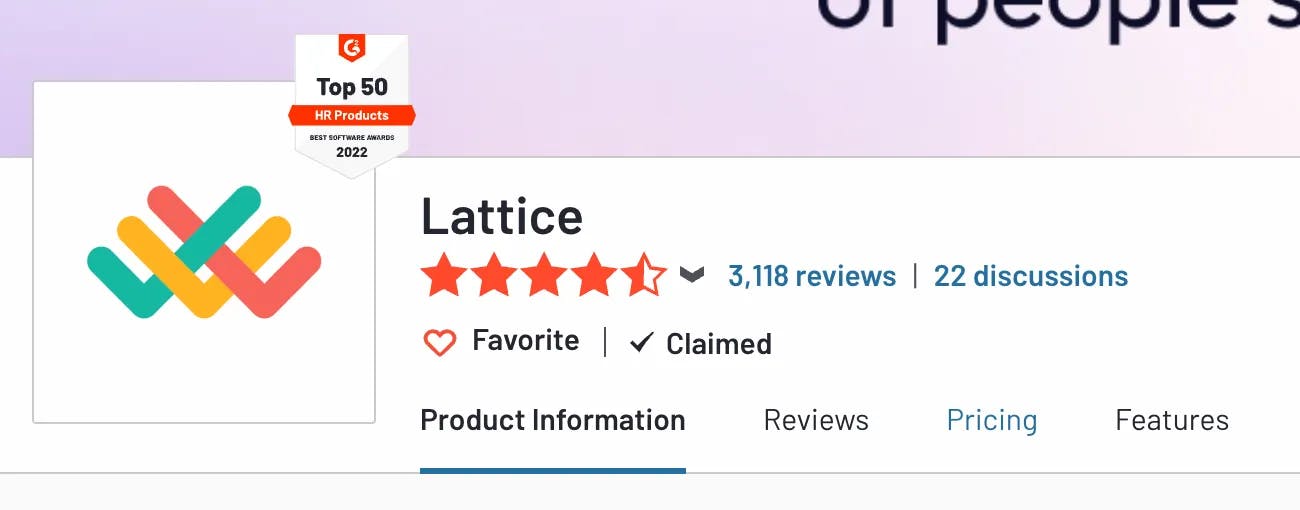
But the road to product-market fit is never an easy one.
The platform today has everything you’d ever need to manage all your people needs, irrespective of your company’s stage.
Here’s what Lattice offers:
🗃 Performance management tools: Reviews 1:1s, updates, feedback, and “Praise” that make continuous performance easy to manage
🥅 OKRs and Goals: Goal management to drive performance
💥 Growth plans: People are more motivated when they know they’re headed towards Growth. Lattice helps employers match competencies to career paths for integrated continuous employee development.
🎯 Engagement: Surveys, pulses, and eNPS to understand and act on how employees feel about their work
📊 Analytics: Actionable people insights for people management teams that lead to impact and success.
💵 Compensation: Connects employee performance and goals with compensation to drive employee engagement and retention.
One size does NOT fit all. Especially when it comes to people success. And Lattice understands this very well. Their website positions their offerings across industries and company size (small businesses vs. Enterprise).
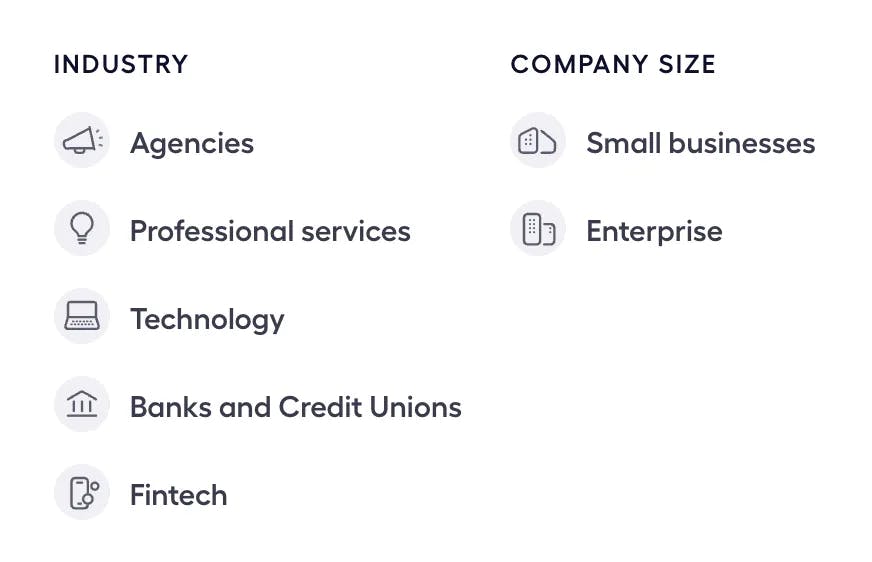
Jack and Eric’s belief in the importance of building employee-centric companies has clearly paid off. Evidence? With $328.5M in total funding, with its latest Series F round of $175 Mn raised earlier this year, Lattice is ranked as one of the fastest growing businesses in the world, growing a whopping 109% year-on-year (on number of customers) just last year.
With 8,000 new features *shudder* already added to their product since v1, Lattice is showing no signs of slowing down.
No, we didn’t add an extra zero by mistake. How did they get here, you ask?
Let’s dive right in! 👇🏼
💬 How do you find product-market fit? Talk to customers!
The v1 bare shell of the product was simple and helped companies set team and company-wide goals (OKRs) and allowed managers and employees to enter and track their progress over time.
They were laser-focused on a single problem - aligning everyone towards a shared goal, especially as a company scales. (a problem far too common in high-growth startups)
Good enough to get them into YC, BUT….
Despite several cos. including Reddit, Teespring, and WePay piloting it, there were not a lot of signups. A month later, they released a check-ins tool - but that didn’t help either.
It wasn’t until they released the Reviews functionality, which helped with real-time feedback and employee engagement, that they got to product-market fit.
Lattice was now a suite of products that brought employee engagement, performance management, and employee development: all under one roof.
So how did they get there?
In yet another episode of Paul Graham’s “Doing things that don’t scale,” Altman’s regular conversations with customers helped take the Lattice team to an important market insight: people were using too many platforms (emails, spreadsheets, PPTs), to analyze information about growth and performance. An all-in-one platform that focused on continuous performance management was how they could differentiate.
Jack’s advice to startups resonates with these early attempts - “Talk to customers like your company depends on it. You’re not going to just dream up product market fit, the market is going to pull it out of you… If you are in the vicinity of a real problem with a real customer, they will be more than willing to do this with you because they will want you to solve their problem.”
When companies began to realize the need to invest in their culture - Lattice was there to help.
📦 Product-led all the way!
By 2018, Lattice’s main focus was to deliver features that would enhance performance management while simultaneously focusing on design and ease of use.
They released Lattice Grow to help companies develop clear growth plans to keep employees motivated and focused on development within the company. What’s more, the host of integrations they offered and a custom API meant companies could manage everything without having to leave the platform!
“I don't know what we would do without Lattice, honestly. How do you collect five different people's feedback, the manager’s feedback, and the employees’ feedback for the manager, and put it all in one place? Before Lattice, we didn't do it because we couldn't do it." Liza Haskell, Chief Administrative Officer - Tide
Word-of-mouth 🗣
Lattice’s their biggest champions? Users. Before they started actively pursuing bigger companies (with bigger ad spends), 75% of their prospects were inbound - a large percentage of which were prospects who’d heard about them through word-of-mouth.
Lattice continues to stay tuned to its customers’ needs. In 2020, at the height of the pandemic, they rolled out an eNPS feature to measure employee satisfaction. At a time when teams were feeling especially distant, Altman and his team realized how important it was that their product contained features to boost employee engagement and measure how everyone was feeling. Lattice provided a structure and a way to engage employees in a world that had lost a lot of that.
Value-packed Templates 🎆
Lattice also provides HR professionals with a silver bullet for the tabula rasa problem. Templates. Sitting at the intersection of bottom-of-funnel content and lead magnets, templates drive organic discovery for the all-in-one platform and are primed to drive subsequent website conversions at the same time.
Reduced time to value? Lead capture? Organic search & discovery? Check, check, and check.

These ready-made questionnaires, development plans etc., spread across categories - Manager tools, performance reviews, goal-setting, employee services, and career growth are interspersed as gated content for lead capture across the Lattice blog. (more on this later)
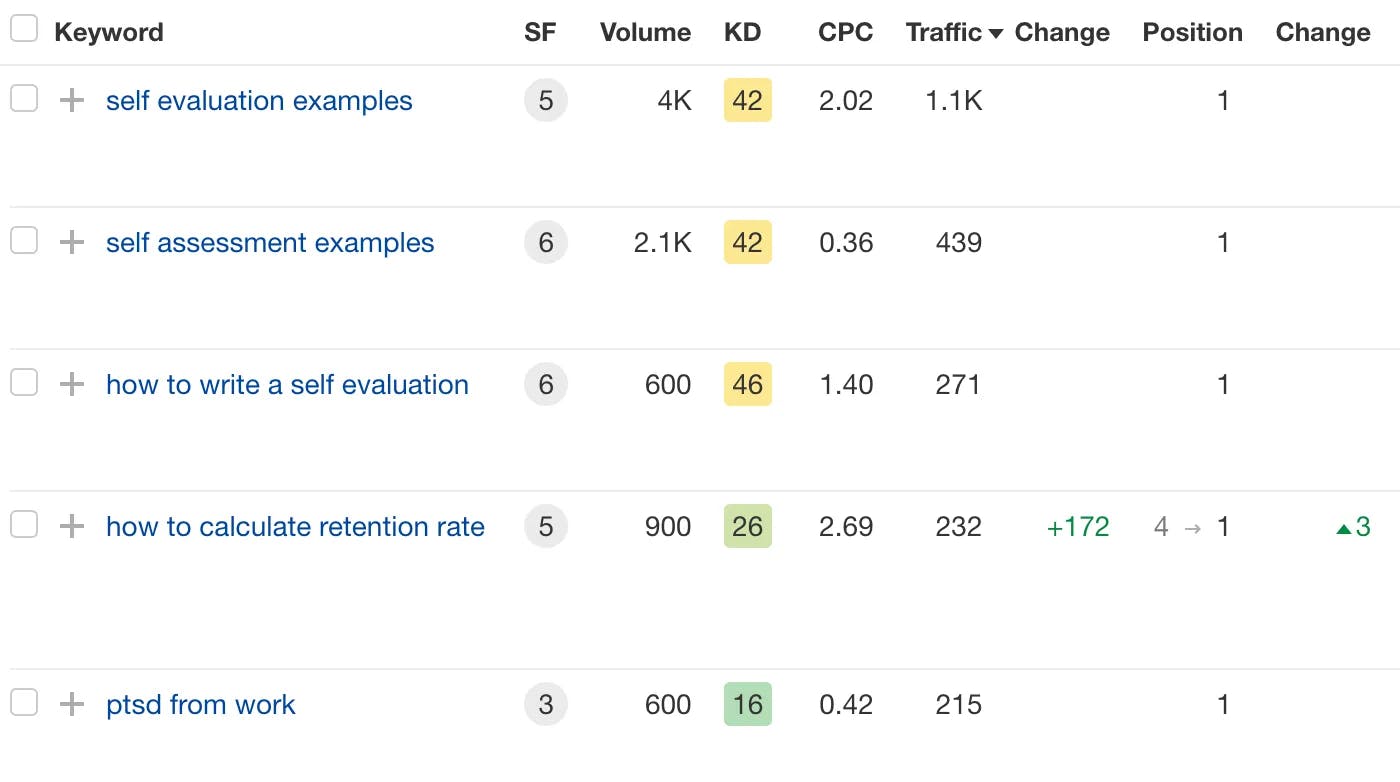
Keyword examples that drive monthly traffic for the Lattice blog
Transparent seat-based pricing 💰
Lattice charges per employee with plans starting from as little as $4 per person.
You can pick and choose the Lattice tools you’re looking for based on goal: Engagement, Grow or go for a 360-degree Performance Management Package (with OKRs & Goals) which starts at $11 per employee.
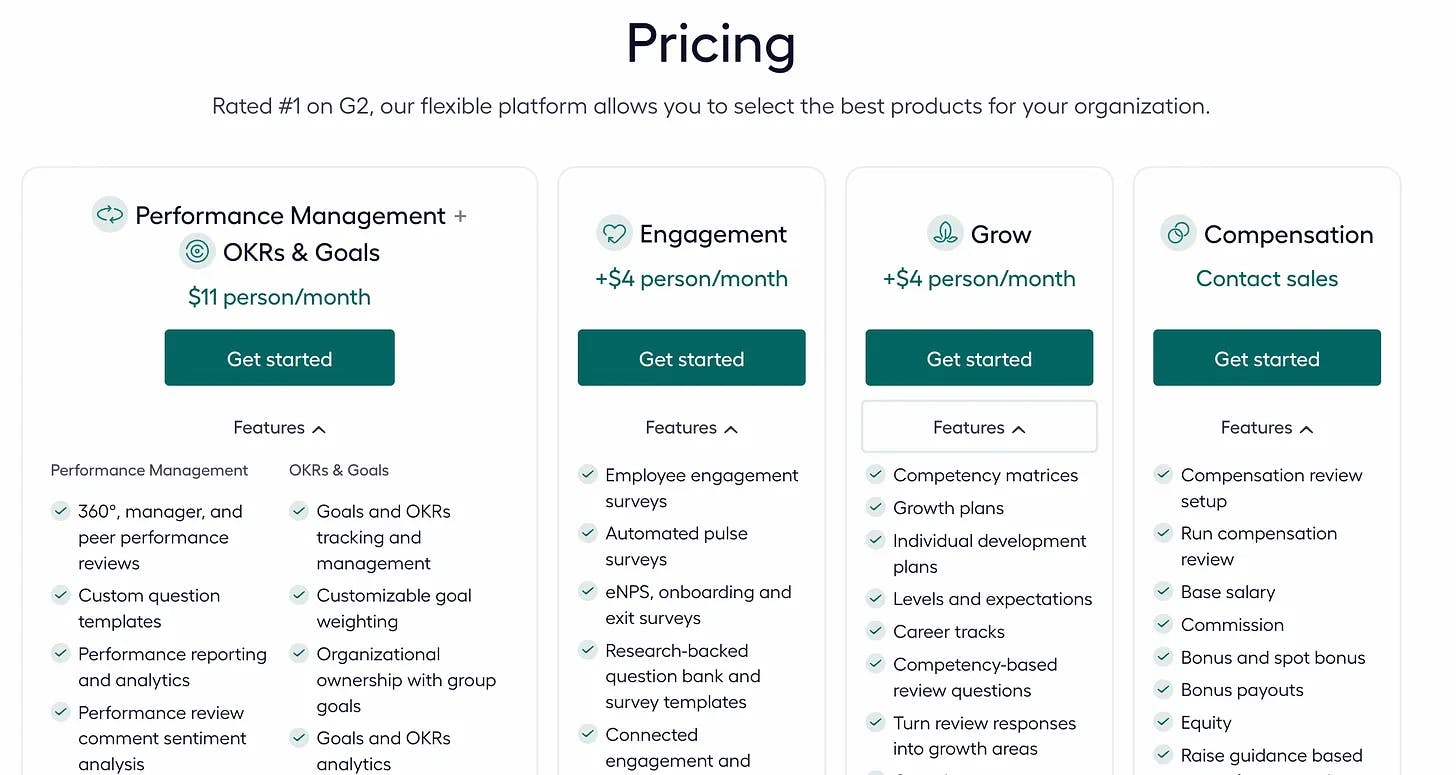
This transparent (and frankly, super affordable) pricing makes it sustainable for all kinds of businesses to get on board with Lattice. And when you grow - Lattice grows with you.
📚 Content HR teams would use - even if they didn’t use Lattice (yet!)
While the product teams focused on adding new features and creating the best possible product, the marketing team focused on content to grow inbounds.
For a relatively unknown company to compete with established ones is tough. But Lattice focused on the one thing they saw not many people were doing - delivering value. Alex Kracov, who used to run marketing at Lattice (before he went on to start Dock), hit on this strategy early on.
“Lattice’s marketing team was run like a media company. Only, it operated inside Lattice, with a single advertiser - and that’s Lattice.”
Lattice’s marketing team produces four broad types of content (that’s gated for lead capture):
- Educational/informative - assessments, research studies, and templates that HR teams can really use
- Third-party evaluations and reports on their performance - like their recently published Forrester report
- Value-driven SEO blogs to get the word out (One of their biggest enterprise customers found them because of a Google search for OKR software!)
- Social proofing - they showcase data-driven stories of how Lattice helped some of their 4,500 customers
💻 Started from a Slack channel - now we are here!
Another huge contributor to Lattice’s growth was its focus on delivering value above all else. As part of this drive, Lattice started a slack channel for HR professionals to connect with each other.
It’s now an international community of over 11,000 HR professionals.
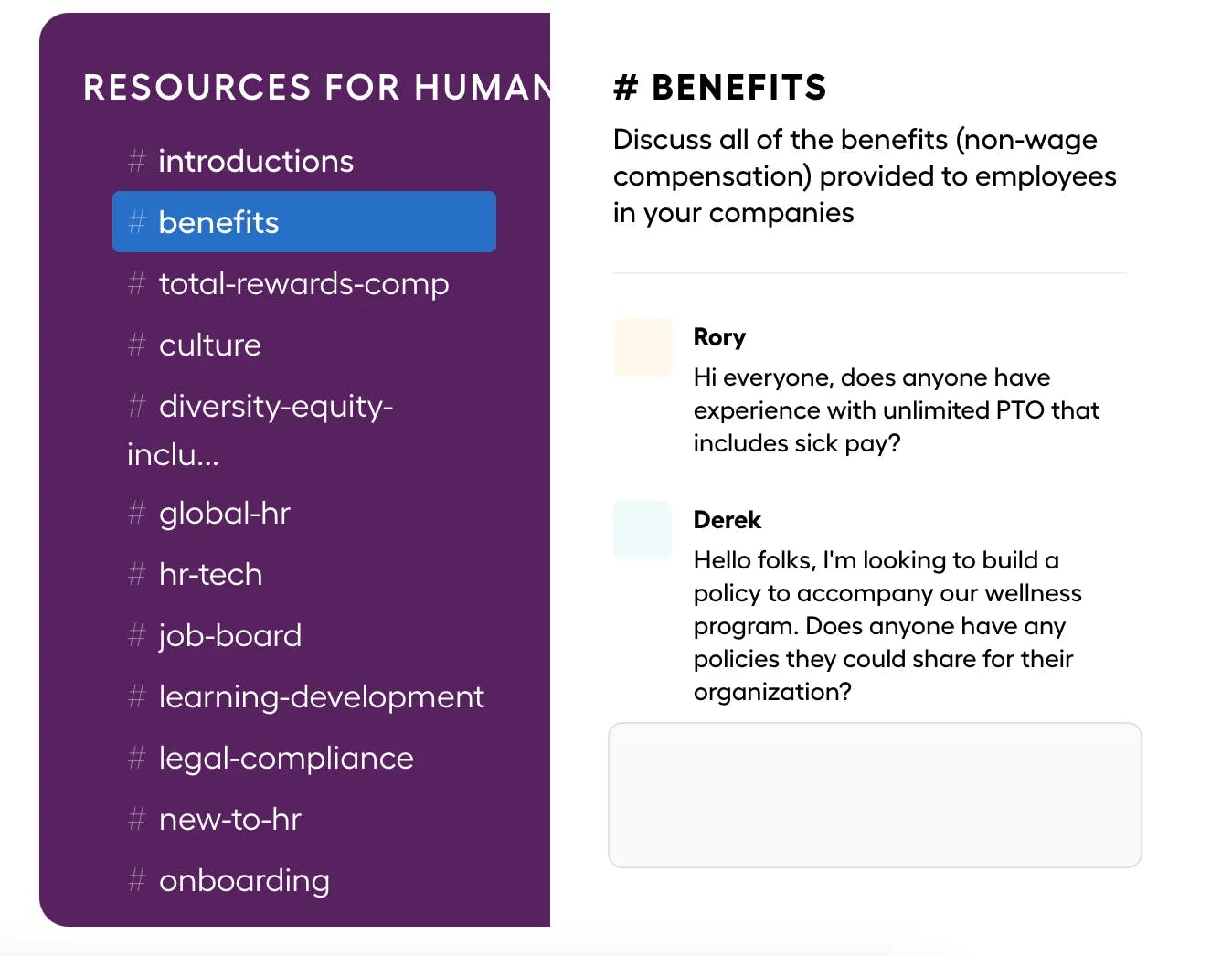
Resources for Humans is a community of HR professionals that’s moderated by Lattice. The community has grown to include:
A weekly newsletter: I ❤️ Humans
Multiple slack channels to deal with everything HR-related - from legal compliance and onboarding to diversity and career development (no Lattice sales teams are allowed in here - even though this is a prime place to convert prospects!)
A Job Board which sources HR/People Ops opportunities straight from the RfH community
A perks program that gives community members special offers from world-class companies like Deel, Bonusly, Lifelabs Learning, Confetti, and more!
Resources for Humans Magazine - curated content for people-focused articles, ideas, and events
An annual conference that has hosted big-name speakers like Serena Williams, Trevor Noah, Adam Grant, and Jason Sudekis.
It’s still paid off - the conference alone has helped drive over 30,000 attendees from cold and warm prospects to paying customers. Who can compete with that?
⏫ ”Perception is reality. Appear bigger than you actually are”
That’s a direct quote from Lattice’s marketing head - Alex Kracov. In 2018, when Lattice was still growing - 75% of its prospects came from inbound. This was great - but their customers were still most SMBs. Alex Krakov quickly realized that if they wanted to grow and reach out to enterprise partners or larger companies, they needed to spend more on outbound.
Even though they weren’t that big, Lattice basically decided to take over SF with billboards.

In 2019, when they launched their performance review platform, they included New York City in their OOH campaign.
Outdoor ads were a brute force way to reach out to larger companies that hadn’t heard of them yet. But it worked. In Krakov’s own words: “Billboards help to drive sales, but also attract investors.” OOH advertising, along with top-notch conferences, celebrity speakers, and banger brand videos, all helped Lattice appear bigger than they were.
The messaging was out there - and bringing in bigger customers.
🎙️ Conversation: the best way to sell
Lattice prides itself on conversational marketing, which brings people back into the business of selling. There are a couple of ways in which they do this:
- Their product demo connects you to a sales rep straight away. This automatically filters out customers with lower buying intent while reducing the friction during the whole sales-to-buying journey.
- During the pandemic, they started Conversations over Coffee - an initiative that sent a potential customer a coffee mug and a gift card to Starbucks with an invite to chat over coffee which helped generate over 130 leads in a single quarter!
“We’re trying to create as little friction as possible - if someone is interested, we want to be sure they’re sent to an SDR right away. We pull in SDRs really early on in the buying journey, so we’re not forcing prospects to go through some nameless, faceless form.” - Sarah Ouyang, Sales OP
As they grew, Lattice divided its sales focus into 2 segments:
- SMBs with 25-50 employees
- Larger businesses with 3000+ workers.
Acquisition that started as primarily inbound soon had to switch gears to outbound by 2019, as the hunt for enterprise logos began.
Apart from the OOH campaigns, they also design highly personalized direct mail campaigns along with surround sound created through press releases and events to support sales - from hosting wine tasting events to webinars and conferences.
But there was one more unlock that would accelerate this growth: Partnerships.
🏢 Partnerships are where it’s at
By 2019, Lattice was actively looking for enterprise clients that would up their ACV. Targeting enterprise needed an entirely different sales strategy - one that still focused on the conversation but at a more customized level.
That’s how their Advisory Services were born. Consulting teams could support demos for larger clients with an added level of personalization. Lattice focused on delivering bespoke knowledge for clients without actively selling their solutions.
You sell with your expertise.
Another strategy that worked for enterprise clients was soft approaches to creating content.
Lattice did with much larger companies - that could be potential customers. They didn’t go in with their sales team - instead, they set up a video camera and invited CEOs and HR heads to talk about their challenges and posted on social media. This ended up associating Lattice with much bigger brands like Asana, Slack and others - who eventually did become customers. It was a great strategy to get their foot in the door!
➡️ What’s next?
After reaching unicorn status in 2021, Lattice continues to grow at record rates as people strategy continues to be a top priority for companies succeeding in the new world of remote work. Lattice brings in structure and a way to engage with employees in a world that have essentially lost this office culture.
When asked what’s next for Lattice, Altman pointed toward AI, “(Lattice) might push into more traditional HR tools, although whatever it brings into the mix — could also include more AI-based automation, but only, when it becomes something useful to helping people be more mindful about work performance.”
People are what set Lattice apart from the beginning. And what will continue to set it apart for whatever comes next?
This story was originally published on Toplyne.
Comments (5)
Vinod Sharma@vinodsharma

Quarterly Planning Workbook
This was a super incredible read for me. Thank you for sharing.
The following two resonated the most with me.
1. People want clear goals, an environment of growth, and highly motivated coworkers from whom they can learn.
"Jack and Eric believed that motivated people are key to business growth. People aren't motivated by snack bars and ping pong tables. Beyond business results, what people really want are clear goals, an environment of growth, and highly motivated coworkers they can learn from."
2. Talk to customers like your company depends on it
Jack’s advice to startups resonates with these early attempts - “Talk to customers like your company depends on it. You’re not going to just dream up product market fit, the market is going to pull it out of you… If you are in the vicinity of a real problem with a real customer, they will be more than willing to do this with you because they will want you to solve their problem.”
Share
This is really insightful.
PixelBin.io
This is great. Thanks for sharing!!
You're so cool! I don't think that read something like this before. So nice to search out anyone with some authentic thoughts on this subject.
But you can also enjoy the best shopping experience with us by Clicking Here . So start shopping now and get free delivery anywhere in the world.
More stories

Mathew Hardy · How To · 3 min read
How to Detect AI Content with Keystroke Tracking

Sanjana Friedman · Opinions · 9 min read
The Case for Supabase

Vaibhav Gupta · Opinions · 10 min read
3.5 Years, 12 Hard Pivots, Still Not Dead
Kyle Corbitt · How To · 5 min read
A Founder’s Guide to AI Fine-Tuning

Chris Bakke · How To · 6 min read
A Better Way to Get Your First 10 B2B Customers
